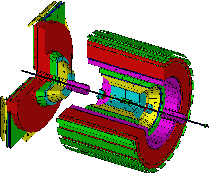| DELPHI experiment: setup and goals |
|
Introduction to the DELPHI experiment
The DELPHI Detector Setup A superconducting solenoid provides a 1.23 T solenoidal field of high uniformity parallel to the beam axis in the volume containing barrel tracking detectors. Tracking relies on the Vertex Detector, the Inner Detector, the Time Projection Chamber, the Outer Detector and forward drift chambers. Electromagnetic showers are measured in the barrel with high granularity by the High Density Projection Chamber, and in the end-caps by the Forward Electromagnetic Calorimeter. The smaller polar angles, essential for detecting electrons and positrons from two-photon processes and for luminosity measurements, were covered until 1994 by the Small Angle Tagger and the Very Small Angle Tagger. Later SAT was replaced with the Small angle TIle Calorimeter. In addition, scintillator systems are implemented in the barrel and forward regions for triggering purposes and in order to achieve complete hermeticity for high energy photon detection. The iron return yoke of the magnet is instrumented with limited streamer mode detectors to create the Hadron Calorimeter which serves also as filter for muons, which are identified in two drift chamber layers. In 1994 a layer of Surrounding Muon Chambers was installed outside the end-caps to fill the gap between the barrel and forward regions. Charged particle identification is provided mainly by liquid and gas Ring Imaging Cherenkov Counters both in barrel and forward regions. |
|
|
| ©1997 Particle Physics, Lund University | ||
